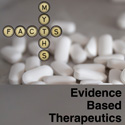Episode 4: De-constructing Risk (or Benefit)
In our fourth installment, we apply the absolute benefit for statin therapy to our patient. We discuss the absolute benefits in context of the individual risk and acknowledge that when translating pooled literature numbers to individual patients an element of mysterious uncertainty always remains (except for James who knows but won’t tell and Mike who doesn’t know but tells us he does).
Show Notes
Definitions
CVD is cardiovascular disease and typically refers to the combination of CHD (coronary heart disease – fatal and non-fatal MIs and sometimes angina) PLUS cerebrovascular disease (fatal and non-fatal strokes – and sometimes TIAs) PLUS (sometimes) other conditions (heart failure, peripheral vascular disease)
Calculating benefit
- Change the factor and recalculate the chance of CVD
- Use the relative benefits seen in clinical trials (typically 5 years in duration) and apply them to the chance calculated for your patient
- Avoid the use of CDV calculators and just use the absolute benefits seen in clinical trials
A synopsis of the relative benefit of drugs
- Statins ? 30%? in CHD (0%? in women)? 5 years
- BP ? 40 %? in strokes and ? 20%? in CHD ? 5 years
- Metformin ? 35%? in CHD and stroke ? 8-10 years
A synopsis of the absolute benefit of drugs
Statins over 5 years in a post MI patient Coronary events ?4% (15% to 11%) Death ?2% (12% to 10%) Strokes ?1% (5% to 4%) Treating a Blood Pressure of 160 /100 mmHg for 5 years CVD ? 1% (4% to 3%)
Absolute benefit of statins over approx 5 years
| Major coronary events (%)* | Death (%) | Strokes (%) | FROM WHAT CVD TO WHAT CVD (%) | |
| Primary | 1-1.5* | – | – | 8-9 to 7 |
| Diabetes | 2 | – | 1-1.5 | 10 to 7 |
| Secondary | 4 | 2 | 1 | 20 to 15 |
* just in males and NO difference in overall serious adverse events
Listening to this episode is for premium podcast members only. If you already have a membership, login to your account. If you aren't yet a premium subscriber, sign up today!


